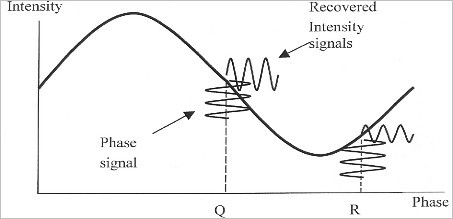
Determinating the phase
In a interferometric assembly, the key to determine the measurand is measuring without ambiguity and with enough sensitivity the phase difference. The intensity of the assemblies we have seen previously varies according to equations [1] and [2].
If we assume that the phase of the signal wave (
 ) is composed of a continuous term and of a harmonic of low amplitude, determinating the measurand will need the interferometer to be configured as on Figure 14, and the best sensitivity will be obtained in Q position. In that case, we say that the (signal and reference) waves are in quadrature.
) is composed of a continuous term and of a harmonic of low amplitude, determinating the measurand will need the interferometer to be configured as on Figure 14, and the best sensitivity will be obtained in Q position. In that case, we say that the (signal and reference) waves are in quadrature.

This position is obtained when the phase difference is:
Some techniques go by adjusting
 (i.e. the phase of the reference wave) to maintain the interferometer in quadrature: )
(i.e. the phase of the reference wave) to maintain the interferometer in quadrature: )
-
you can vary the length of the fiber by the aid of the piezoelectrical element [36].
-
or vary the wavelength of the laser diode by controlling the injection current or the temperature [37].
Some passive techniques are also possible, they use predetermined sequences of the reference wave's phase difference. As an example, if you create a
 rads phase difference, the output intensity is:
rads phase difference, the output intensity is:
with i varying from 1 to 4.
A combination of the four intensities gives as a phase difference:
Finally, we can mention the method based on adding an alternative discrepancy of
 , which resembles the phase modulation of the carrier. The intensity can be written as:
, which resembles the phase modulation of the carrier. The intensity can be written as:
With techniques of phase-locked loop well known in electronics, you can get the demodulation.